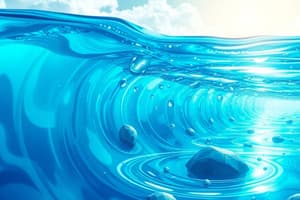Podcast
Questions and Answers
Which of the following are sources of surface water?
Which of the following are sources of surface water?
- Springs
- Lakes and ponds (correct)
- Rivers (correct)
- Wells
Water pollution means any alteration of the physical, chemical, biological or radiological properties of a water body resulting in the impairment of its __________.
Water pollution means any alteration of the physical, chemical, biological or radiological properties of a water body resulting in the impairment of its __________.
purity or quality
What are the typical physical parameters that determine water pollution?
What are the typical physical parameters that determine water pollution?
Color, odor, turbidity, density, temperature
Which of the following are types of inorganic pollutants?
Which of the following are types of inorganic pollutants?
Sediments are soluble particles that enter water bodies by soil erosion.
Sediments are soluble particles that enter water bodies by soil erosion.
What is described as the worst pollution, detrimental to health?
What is described as the worst pollution, detrimental to health?
Thermal pollutants can decrease the __________ level of water.
Thermal pollutants can decrease the __________ level of water.
Which are examples of point sources of water pollutants?
Which are examples of point sources of water pollutants?
What does water pollution refer to?
What does water pollution refer to?
Which of the following are physical parameters of water pollution? (Select all that apply)
Which of the following are physical parameters of water pollution? (Select all that apply)
What are considered organic pollutants?
What are considered organic pollutants?
What is the main source of thermal pollutants?
What is the main source of thermal pollutants?
Sediments are classified as a biological pollutant.
Sediments are classified as a biological pollutant.
What are point sources of pollutants?
What are point sources of pollutants?
Which of the following sources can lead to radioactive pollution? (Select all that apply)
Which of the following sources can lead to radioactive pollution? (Select all that apply)
Flashcards are hidden until you start studying
Study Notes
Water Environment
- Water is essential for life.
- Water sources can be surface or subsurface.
- Surface water sources include rivers, lakes, ponds, impounded reservoirs.
- Subsurface water sources include springs, infiltration galleries, and wells.
Water Quality
- Water pollution can alter the physical, chemical, biological, and radiological properties of water.
- Water pollution impairs water purity and quality.
- Water quality can be determined by physical parameters such as color, odor, turbidity, density, and temperature.
- Water quality can be determined by chemical parameters such as pH, total dissolved solids (TDS), dissolved oxygen (DO), chemical oxygen demand (COD), and biochemical oxygen demand (BOD).
- Water quality can be determined by biological parameters such as microorganisms, bacteria, algae, protozoa, and crustaceans.
Types of Water Pollutants
- Organic pollutants include degradable and non-degradable products, disease-causing agents, plant nutrients, sewage, synthetic organic compounds, and oil.
- Organic pollutants can decrease the dissolved oxygen (DO) level in water.
- Inorganic pollutants include inorganic salts, finely divided metal or metal compounds, trace elements, and mineral acids.
- Sediments are insoluble soil particles that enter waterways through erosion.
- Sediments are the most extensive pollutants of surface waters.
- Agricultural practices construction activities, and strip mining all contribute to sediment erosion.
- Radioactive pollution is caused by natural sources such as cosmic rays and artificial sources such as nuclear plants.
- Radioactive pollution is detrimental to health.
- Thermal pollutants are caused by the release of heated water from industries such as coal-fired and nuclear power plants.
- Thermal pollutants decrease the dissolved oxygen (DO) level in water.
Main Sources of Pollutants
- Point sources are readily identifiable at a single location, and include:
- Industrial waste disposal
- Leaching residue tips
- Water treatment plants
- Sanitary landfills
- Municipal sewage leakage
- Aerial fallout
- Combined sewer overflows
- Industrial effluent seepage
- Raw sewage
### Water Environment
- Water is sourced from both surface and subsurface.
- Surface water sources include rivers, lakes, ponds, streams, and impounded reservoirs.
- Subsurface water sources include springs, infiltration galleries, and wells.
Water Quality
- Water pollution impacts water quality by altering its physical, chemical, biological, and radiological properties.
- Key parameters of water pollution include physical, chemical, and biological properties.
- Physical parameters: color, odor, turbidity, density, temperature, and so on.
- Chemical parameters: pH, total dissolved solids (TDS), ionic composition, suspended solids, dissolved oxygen (DO), residual chlorine, chemical oxygen demand (COD), biochemical oxygen demand (BOD), redox potential, radioactive substances, organic materials, metallic ions (including heavy metals), oxides, and industrial byproducts.
- Biological parameters: microorganisms, bacteria, algae, protozoa, and crustaceans.
Types of water pollutants
- Organic pollutants include degradable and non-degradable products, disease-causing agents, plant nutrients, sewage, synthetic organic compounds, and oil. They lower the Dissolved oxygen (DO) in the water.
- Inorganic pollutants include inorganic salts, finely divided metal or metal compounds, trace elements, mineral acid, and complexes of metal with organic moieties.
- Sediments are insoluble soil particles that enter water bodies through soil erosion. They are a significant source of water pollution with sedimentation rates often exceeding solids loading from sewage discharge.
- Radioactive substances are the most detrimental pollutants to health. Sources include cosmic rays and nuclear plants.
- Thermal pollutants are generated by coal-fired or nuclear fuel power plants that utilize water from nearby rivers, lakes, or municipal sources to cool their operations. The heated water then discharges back into the water body, decreasing DO and affecting aquatic life.
Main sources of pollutants
- Point sources are easily identifiable at a single location.
- Industrial waste disposal, leaching residue tips, water treatment plant, sanitary landfills, municipal sewage leakage, aerial fallout, combined sewer overflows, industrial effluent seepage, and raw sewage are examples of point sources.
Studying That Suits You
Use AI to generate personalized quizzes and flashcards to suit your learning preferences.




